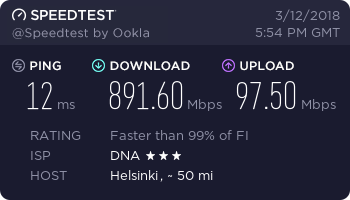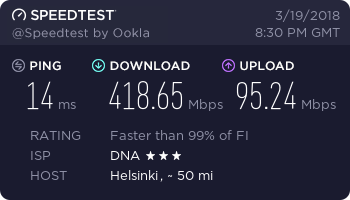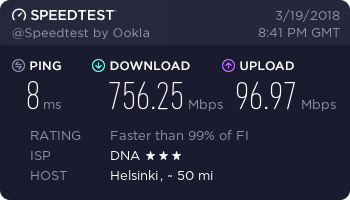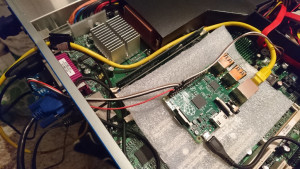Hardware: Lenovo ThinkPad W550s with Sierra Wireless EM7345
Software: Debian 10 (buster/testing)
Operator: Sonera (Finland)
After Debian installation the modem is recognized, but somehow a working connection just can’t be created:
# mmcli -L Found 1 modems: /org/freedesktop/ModemManager1/Modem/0 [Sierra Wireless Inc.] Sierra Wireless EM7345 4G LTE # mmcli -m 0 /org/freedesktop/ModemManager1/Modem/0 (device id '<snip>') ------------------------- Hardware | manufacturer: 'Sierra Wireless Inc.' | model: 'Sierra Wireless EM7345 4G LTE' | revision: 'V1.1,11' | H/W revision: 'unknown' | supported: 'gsm-umts, lte' | current: 'gsm-umts, lte' | equipment id: '<snip>' ------------------------- System | device: '/sys/devices/pci0000:00/0000:00:14.0/usb2/2-4' | drivers: 'cdc_acm, cdc_ncm' | plugin: 'Generic' | primary port: 'ttyACM0' | ports: 'enx000011121314 (net), ttyACM0 (at), ttyACM2 (at)' ------------------------- Numbers | own : 'unknown' ------------------------- Status | lock: 'none' | unlock retries: 'sim-pin (3), sim-pin2 (3), sim-puk (10), sim-puk2 (10)' | state: 'registered' | power state: 'on' | access tech: 'lte' | signal quality: '35' (recent) ------------------------- Modes | supported: 'allowed: 2g, 3g, 4g; preferred: none' | current: 'allowed: 2g, 3g, 4g; preferred: none' ------------------------- Bands | supported: 'unknown' | current: 'unknown' ------------------------- IP | supported: 'ipv4, ipv6, ipv4v6' ------------------------- 3GPP | imei: '<snip>' | enabled locks: 'none' | operator id: '24491' | operator name: 'FI SONERA' | subscription: 'unknown' | registration: 'home' | EPS UE mode: 'csps-2' ------------------------- SIM | path: '/org/freedesktop/ModemManager1/SIM/0' ------------------------- Bearers | paths: '/org/freedesktop/ModemManager1/Bearer/0' # nmcli connection add type gsm ifname "" con-name 4G apn internet connection.autoconnect no Connection '4G' (ef2b6f2d-e072-44cf-a9f8-831b79b179f2) successfully added. # nmcli connection up 4G Error: Connection activation failed: Unknown error
daemon.log revealed that modem got stuck on “Connect: ppp0 <–> /dev/ttyACM0” and a bit later on “Couldn’t initialize PDP context with our APN: ‘Serial command timed out'”
Problem seems to be that NCM -mode isn’t actually supported by EM7345 – even though advertised by the firmware (and H/W revision says unknown). Small confirmation for this theory is that Lenovo provides drivers for older Windows versions where MBIM isn’t natively supported.
Let’s override defaults for cdc_ncm and prefer MBIM -mode.
# cat /sys/module/cdc_ncm/parameters/prefer_mbim N # echo "options cdc_ncm prefer_mbim=Y" > /etc/modprobe.d/cdc_ncm.conf # modprobe -r cdc_mbim cdc_ncm # modprobe cdc_mbim # cat /sys/module/cdc_ncm/parameters/prefer_mbim Y # systemctl restart ModemManager # mmcli -L Found 1 modems: /org/freedesktop/ModemManager1/Modem/0 [Sierra Wireless Inc.] MBIM [1199:A001] # mmcli -m 0 /org/freedesktop/ModemManager1/Modem/0 (device id '<snip>') ------------------------- Hardware | manufacturer: 'Sierra Wireless Inc.' | model: 'MBIM [1199:A001]' | revision: 'FIH7160_V1.2_WW_01.1616.01' | H/W revision: 'XMM7160_V1.2_MBIM_GNSS_NAND_RE' | supported: 'gsm-umts, lte' | current: 'gsm-umts, lte' | equipment id: '<snip>' ------------------------- System | device: '/sys/devices/pci0000:00/0000:00:14.0/usb2/2-4' | drivers: 'cdc_acm, cdc_mbim' | plugin: 'Sierra' | primary port: 'cdc-wdm0' | ports: 'wwp0s20u4 (net), cdc-wdm0 (mbim), ttyACM0 (at), ttyACM2 (at)' ------------------------- Numbers | own : 'unknown' ------------------------- Status | lock: 'none' | unlock retries: 'sim-pin2 (3)' | state: 'registered' | power state: 'on' | access tech: 'lte' | signal quality: '35' (recent) ------------------------- Modes | supported: 'allowed: 2g, 3g, 4g; preferred: none' | current: 'allowed: 2g, 3g, 4g; preferred: none' ------------------------- Bands | supported: 'unknown' | current: 'unknown' ------------------------- IP | supported: 'ipv4, ipv6, ipv4v6' ------------------------- 3GPP | imei: '<snip>' | enabled locks: 'fixed-dialing' | operator id: '24491' | operator name: 'FI SONERA' | subscription: 'unknown' | registration: 'home' | EPS UE mode: 'csps-2' ------------------------- SIM | path: '/org/freedesktop/ModemManager1/SIM/0' ------------------------- Bearers | paths: 'none' # nmcli connection up 4G Error: Timeout expired (90 seconds)
…but still not quite there.
This time daemon.log says that the modem was stuck in 3GPP Registration state loop, idle -> registering -> home -> idle.
Reason for this behavior is Sonera, which (still) doesn’t support IPv6, and somehow fails the handshake if IP type ipv4v6 is offered first. Debug was done by running simple-connect manually:
# systemctl restart ModemManager # mmcli -m 0 --simple-connect="apn=internet,ip-type=ipv4" successfully connected the modem # mmcli -m 0 --simple-disconnect successfully disconnected all bearers in the modem # systemctl restart ModemManager # mmcli -m 0 --simple-connect="apn=internet,ip-type=ipv4v6" error: couldn't connect the modem: 'Timeout was reached' # systemctl restart ModemManager # mmcli -m 0 --simple-connect="apn=internet,ip-type=ipv4" successfully connected the modem # mmcli -m 0 --simple-disconnect successfully disconnected all bearers in the modem
So, how to translate this to network-manager actually handling the connection? Luckily just ignoring IPv6 altogether changes ip-type -setting, so (with nmcli) this is quite easily fixable:
# nmcli connection modify 4G ipv6.method ignore # nmcli connection up 4G Connection successfully activated (D-Bus active path: /<snip>)
…and finally, a working connection.










